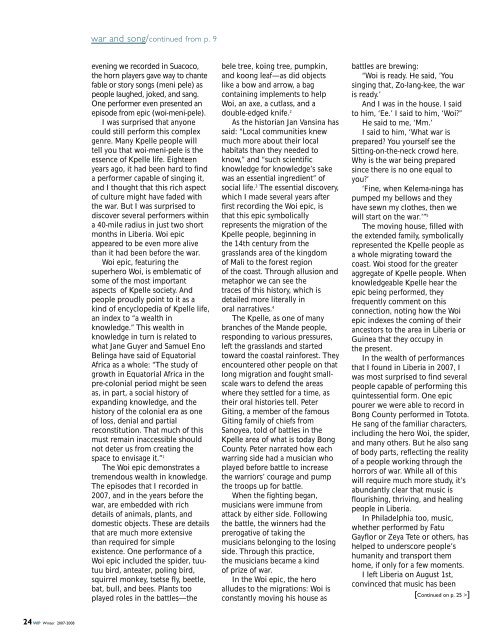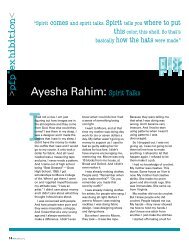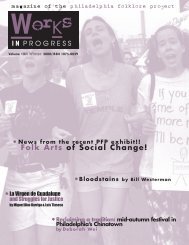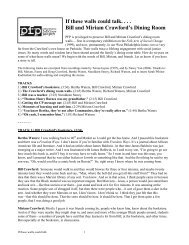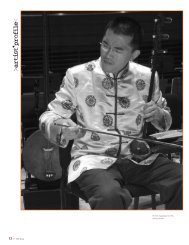African song / Fatu Gayflor ⢠War and wealth - Philadelphia Folklore ...
African song / Fatu Gayflor ⢠War and wealth - Philadelphia Folklore ...
African song / Fatu Gayflor ⢠War and wealth - Philadelphia Folklore ...
Create successful ePaper yourself
Turn your PDF publications into a flip-book with our unique Google optimized e-Paper software.
war <strong>and</strong> <strong>song</strong>/continued from p. 9<br />
evening we recorded in Suacoco,<br />
the horn players gave way to chante<br />
fable or story <strong>song</strong>s (meni pele) as<br />
people laughed, joked, <strong>and</strong> sang.<br />
One performer even presented an<br />
episode from epic (woi-meni-pele).<br />
I was surprised that anyone<br />
could still perform this complex<br />
genre. Many Kpelle people will<br />
tell you that woi-meni-pele is the<br />
essence of Kpelle life. Eighteen<br />
years ago, it had been hard to find<br />
a performer capable of singing it,<br />
<strong>and</strong> I thought that this rich aspect<br />
of culture might have faded with<br />
the war. But I was surprised to<br />
discover several performers within<br />
a 40-mile radius in just two short<br />
months in Liberia. Woi epic<br />
appeared to be even more alive<br />
than it had been before the war.<br />
Woi epic, featuring the<br />
superhero Woi, is emblematic of<br />
some of the most important<br />
aspects of Kpelle society. And<br />
people proudly point to it as a<br />
kind of encyclopedia of Kpelle life,<br />
an index to “a <strong>wealth</strong> in<br />
knowledge.” This <strong>wealth</strong> in<br />
knowledge in turn is related to<br />
what Jane Guyer <strong>and</strong> Samuel Eno<br />
Belinga have said of Equatorial<br />
Africa as a whole: “The study of<br />
growth in Equatorial Africa in the<br />
pre-colonial period might be seen<br />
as, in part, a social history of<br />
exp<strong>and</strong>ing knowledge, <strong>and</strong> the<br />
history of the colonial era as one<br />
of loss, denial <strong>and</strong> partial<br />
reconstitution. That much of this<br />
must remain inaccessible should<br />
not deter us from creating the<br />
space to envisage it.” 1<br />
The Woi epic demonstrates a<br />
tremendous <strong>wealth</strong> in knowledge.<br />
The episodes that I recorded in<br />
2007, <strong>and</strong> in the years before the<br />
war, are embedded with rich<br />
details of animals, plants, <strong>and</strong><br />
domestic objects. These are details<br />
that are much more extensive<br />
than required for simple<br />
existence. One performance of a<br />
Woi epic included the spider, tuutuu<br />
bird, anteater, poling bird,<br />
squirrel monkey, tsetse fly, beetle,<br />
bat, bull, <strong>and</strong> bees. Plants too<br />
played roles in the battles—the<br />
bele tree, koing tree, pumpkin,<br />
<strong>and</strong> koong leaf—as did objects<br />
like a bow <strong>and</strong> arrow, a bag<br />
containing implements to help<br />
Woi, an axe, a cutlass, <strong>and</strong> a<br />
double-edged knife. 2<br />
As the historian Jan Vansina has<br />
said: “Local communities knew<br />
much more about their local<br />
habitats than they needed to<br />
know,” <strong>and</strong> “such scientific<br />
knowledge for knowledge’s sake<br />
was an essential ingredient” of<br />
social life. 3 The essential discovery,<br />
which I made several years after<br />
first recording the Woi epic, is<br />
that this epic symbolically<br />
represents the migration of the<br />
Kpelle people, beginning in<br />
the 14th century from the<br />
grassl<strong>and</strong>s area of the kingdom<br />
of Mali to the forest region<br />
of the coast. Through allusion <strong>and</strong><br />
metaphor we can see the<br />
traces of this history, which is<br />
detailed more literally in<br />
oral narratives. 4<br />
The Kpelle, as one of many<br />
branches of the M<strong>and</strong>e people,<br />
responding to various pressures,<br />
left the grassl<strong>and</strong>s <strong>and</strong> started<br />
toward the coastal rainforest. They<br />
encountered other people on that<br />
long migration <strong>and</strong> fought smallscale<br />
wars to defend the areas<br />
where they settled for a time, as<br />
their oral histories tell. Peter<br />
Giting, a member of the famous<br />
Giting family of chiefs from<br />
Sanoyea, told of battles in the<br />
Kpelle area of what is today Bong<br />
County. Peter narrated how each<br />
warring side had a musician who<br />
played before battle to increase<br />
the warriors’ courage <strong>and</strong> pump<br />
the troops up for battle.<br />
When the fighting began,<br />
musicians were immune from<br />
attack by either side. Following<br />
the battle, the winners had the<br />
prerogative of taking the<br />
musicians belonging to the losing<br />
side. Through this practice,<br />
the musicians became a kind<br />
of prize of war.<br />
In the Woi epic, the hero<br />
alludes to the migrations: Woi is<br />
constantly moving his house as<br />
battles are brewing:<br />
“Woi is ready. He said, ’You<br />
singing that, Zo-lang-kee, the war<br />
is ready.’<br />
And I was in the house. I said<br />
to him, ‘Ee.’ I said to him, ‘Woi?”<br />
He said to me, ‘Mm.’<br />
I said to him, ‘What war is<br />
prepared? You yourself see the<br />
Sitting-on-the-neck crowd here.<br />
Why is the war being prepared<br />
since there is no one equal to<br />
you?’<br />
‘Fine, when Kelema-ninga has<br />
pumped my bellows <strong>and</strong> they<br />
have sewn my clothes, then we<br />
will start on the war.’” 5<br />
The moving house, filled with<br />
the extended family, symbolically<br />
represented the Kpelle people as<br />
a whole migrating toward the<br />
coast. Woi stood for the greater<br />
aggregate of Kpelle people. When<br />
knowledgeable Kpelle hear the<br />
epic being performed, they<br />
frequently comment on this<br />
connection, noting how the Woi<br />
epic indexes the coming of their<br />
ancestors to the area in Liberia or<br />
Guinea that they occupy in<br />
the present.<br />
In the <strong>wealth</strong> of performances<br />
that I found in Liberia in 2007, I<br />
was most surprised to find several<br />
people capable of performing this<br />
quintessential form. One epic<br />
pourer we were able to record in<br />
Bong County performed in Totota.<br />
He sang of the familiar characters,<br />
including the hero Woi, the spider,<br />
<strong>and</strong> many others. But he also sang<br />
of body parts, reflecting the reality<br />
of a people working through the<br />
horrors of war. While all of this<br />
will require much more study, it’s<br />
abundantly clear that music is<br />
flourishing, thriving, <strong>and</strong> healing<br />
people in Liberia.<br />
In <strong>Philadelphia</strong> too, music,<br />
whether performed by <strong>Fatu</strong><br />
<strong>Gayflor</strong> or Zeya Tete or others, has<br />
helped to underscore people’s<br />
humanity <strong>and</strong> transport them<br />
home, if only for a few moments.<br />
I left Liberia on August 1st,<br />
convinced that music has been<br />
[Continued on p. 25 >]<br />
24 WIP Winter 2007-2008


